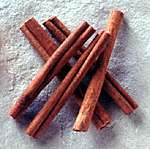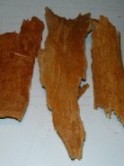 |
CINNAMALDEHYDEThe smell and flavour of cinnamon |
 |
 |
CINNAMALDEHYDEThe smell and flavour of cinnamon |
 |
Paul M. Burnham
Hillsborough College, Sheffield, UK
Also available: HTML-only, Chime Enhanced and JMol versions.
| CINNAMON | |
The spice we know as cinnamon is the dried bark of the small evergreen tree Cinnamomum zeylanicum which grows in Sri Lanka and southern India (pictured right). The bark of this tree is often referred to as "Ceylon cinnamon" or "true cinnamon". This is to differentiate it from the bark of a related tree, Cinnamomum cassia (L.) Presl, the bark of which is often referred to as "Chinese cinnamon". Although the spices from the two trees taste similar, connoisseurs suggest that Chinese cinnamon has a slightly bitter flavour compared to Ceylon cinnamon. Most commercial ground cinnamon is often a mixture of true cinnamon and cassia. In some cases it may be entirely cassia. |
 |
| USES OF CINNAMON | |
 |
Cinnamon has been known of for many years and its uses are wide ranging. It was regarded as a spice of high value by many different civilisations. In biblical times it was used as a perfume in anointing oil and also for beds. The fragrance of cinnamon was also exploited by the Egyptians who are believed to have used the spice when embalming mummies. The Romans also placed a high value on cinnamon. It is said that the emperor Nero (shown left) burned a year’s supply of the spice at the funeral of his second wife, Poppaea Sabina. This act was carried out to indicate the extent of the remorse he felt after allegedly murdering her (it is thought that he kicked her to death). |
Cinnamaldehyde, or 3-phenylprop-2-enal to use its IUPAC name, is an oily yellow liquid at room temperature with a boiling point of 246 °C. Cinnamaldehyde can be made synthetically but is more commonly obtained from the steam distillation of the oil of cinnamon bark which is a much more efficient process. It is mainly used as a flavouring agent or as a scent for candles. It is non-toxic but can irritate skin if in contact for too long. As with many components of essential oils cinnamaldehyde displays antiviral, antibacterial and antifungal properties. It is also reported to be a good pesticide. These properties support the medicinal and soothing properties of cinnamon bark. A minor component of cinnamon oil is eugenol (shown below). This compound makes up about 10% of the oil and displays antiseptic and analgesic properties which may also contribute to cinnamon's soothing effect. |
 |
| Eugenol, C10H12O2 |
| BIBLIOGRAPHY |